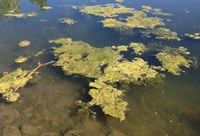"Hey, Why's the Water Green?"
February 28, 2018 - Sometimes visitors to Tingley Beach ask why the water looks green. The simple answer: it's supposed to be!
That green stuff you see is algae, and that algae is an important part of the aquatic ecosystem. Algae is the basis of the aquatic food chain, and it converts carbon dioxide to oxygen through photosynthesis (with a little help from light and nutrients). When the amount of sunlight and biological activity in the ponds increase (especially in the spring), the algae “blooms.” In this way, algae (aquatic plants) are just like land-based plants.
The ponds at Tingley Beach have both microscopic and filamentous algae. The filamentous algae looks like wet wool, and causes more problems than the microscopic varieties. While some algae is healthy and beneficial to water quality and biological habitat, it is important that it does not become too abundant.
Tingley Beach staff manage algae using a variety of methods including creating changes in the water level, increasing water mixing, adding algae-eating fish, and physically removing the filamentous algae. Algicides (chemicals used to kill algae) are not used at Tingley Beach because they could interrupt the functioning of the pond ecosystem.
"Because algae plays a role in the function of a healthy aquatic ecosytem, the goal of pond management should be to maintain a balance among all of the different components of the ecosystem," said Kathy Lang, ABQ BioPark Tingley Beach curator. "Any efforts to control algae growth in ponds should focus only on reducing excessive amounts of algae rather than trying to eliminate it entirely."
To learn more about pond health and the management policies used at the ABQ BioPark, come to A Look Under the Surface, A Science Cafe, from 6:30-8:30 p.m. March 7 at Tingley Beach. Learn more.


